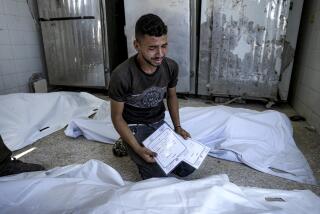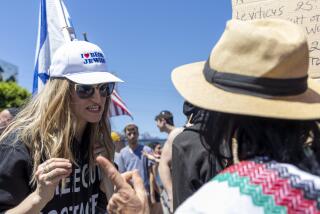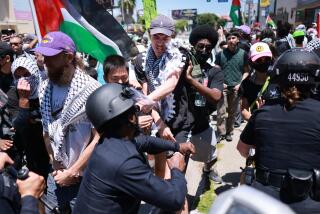Sharon’s Temple Mount Foray Highlights Bitter Issue
- Share via
JERUSALEM — Subtlety is not Ariel Sharon’s strong suit.
Flanked by hundreds of police officers in riot gear and with helicopters flying overhead, Sharon led a small knot of right-wing politicians onto the holiest and most bitterly contested site in Jerusalem’s Old City early Thursday, sparking riots that left dozens of Palestinians and Israeli troops injured.
Sharon’s foray onto the Temple Mount, a 36-acre plateau known to Muslims as Haram al Sharif, or the noble sanctuary, was a highly charged attempt to assert Israeli authority over a site sacred to two faiths.
Palestinians saw the move as a provocation timed to disrupt delicate peace negotiations with Israel.
“What provocation is it when Jews come to this holiest place?” asked Sharon, hawkish leader of the opposition Likud Party. “I came here with a message of peace.”
As he spoke, emergency medics rushed by, hauling wounded Israelis on stretchers.
Clashes later spread to the West Bank city of Ramallah but soon subsided. None of the day’s injuries were serious, although an Israeli soldier died of wounds sustained in an overnight bombing in the Gaza Strip.
Jews believe the biblical First and Second temples were constructed where the Temple Mount stands today, making it the holiest site in Judaism. The compound in the southeastern corner of the ancient walled city is also home to the Al Aqsa Mosque and the Dome of the Rock, from where Muslims believe the prophet Muhammad ascended to heaven. This is the third holiest site in Islam, after Mecca and Medina.
Sovereignty over the tree-shaded plateau is the most intractable of the issues that have stymied negotiations aimed at ending decades of bloody conflict. So sensitive is the Temple Mount that deadly riots have erupted twice in the last decade merely over rumors that one side or the other was tampering with the status quo.
Israel captured the Old City and East Jerusalem in the 1967 Middle East War and claims the areas as part of its capital. Palestinians want East Jerusalem and most of the Old City as the capital of their eventual independent state.
Israel has allowed the day-to-day running of the Temple Mount to remain in the hands of Muslim clerics of the Islamic Trust, or Waqf, though overall security is the purview of the Israelis.
Sharon and his entourage said they were interested in inspecting recent construction in the compound near the medieval underground vaults known as Solomon’s Stables. There the Islamic Trust has built a new mosque, to the horror of many Israelis.
Hundreds of police officers were deployed throughout the Old City and on a long ramp that leads up to the Temple Mount entrance. Television satellite trucks provided live coverage.
Police blocked dozens of foreign and Israeli reporters from accompanying Sharon, but several Palestinian reporters who entered through a Muslims-only entrance earlier in the day were able to provide accounts of the visit.
With bodyguards forming a tight circle around Sharon and other legislators, the tour was relatively peaceful until the group attempted to descend into Solomon’s Stables. About 20 Palestinians blocked their way and scuffled with police.
“We tried to prevent them from entering, and we succeeded,” said Hamad Abudiab, 60, whose head was bleeding where he said Israeli police had clubbed him.
Sharon and his entourage spent about an hour in the compound, while a small group of protesters chanted “Murderer!” and “Allahu akbar [God is great]!” As Sharon left, he was followed by furious Arab members of Israel’s parliament, or Knesset, who waved their fists at him and jabbed their fingers in the air.
“This is Palestinian! This belongs to us!” screamed Ahmed Tibi, a member of the Knesset and a former aide to Palestinian Authority President Yasser Arafat.
In the waiting crowd below Temple Mount, Jews who came to support Sharon chanted: “This is Jewish land! Get out!” And some hailed Sharon: “King of Israel!”
It was after Sharon departed the area that the most serious violence erupted. Police began to relax their barricades, and hundreds of Palestinians--most students, their school bags in tow--surged toward the Dome of the Rock. Pledging to “defend Al Aqsa with our blood and our soul,” they hurled rocks and bottles at police, who responded by firing several rounds of rubber-coated bullets.
Police said about 25 officers received mostly minor injuries. Palestinians reported three protesters were injured by bullets and two by beatings.
Israeli police commanders said they were relieved that the clashes did not escalate further. Among the people spotted in the Palestinian crowd were Marwan Barghouti, head of Arafat’s Fatah movement, which had vowed to disrupt the Sharon visit. Also present was a senior intelligence officer in one of Arafat’s security services, Tawfiq Tirawi, who was dressed in civilian clothes.
Sharon is easily one of the most reviled people in the Arab world. He was the architect of Israel’s 1982 invasion and occupation of Lebanon, and in 1983 he was drummed out of the Israeli government after a state committee held him partly responsible for the massacre by Israel’s Lebanese allies of hundreds of Palestinian civilians in the Sabra and Shatila refugee camps outside Beirut.
Sharon opposes any concessions to Palestinians over Jerusalem, which he believes should be maintained as the “eternal and indivisible” capital of Israel and the Jewish people.
He said Thursday that his visit served to boost Jewish claims to the Temple Mount, especially as Prime Minister Ehud Barak proposes sharing control over parts of Jerusalem with the Palestinians. It also served to boost Sharon in his forthcoming battle with former Prime Minister Benjamin Netanyahu for leadership of the Likud Party. Netanyahu, who escaped prosecution on corruption charges, is expected to return to politics.
While Jewish and Arab Knesset members traded accusations over who was the greater agitator Thursday, Arafat was asked about Sharon’s visit. The Palestinian leader said it was “a very dangerous act,” and he urged the Arab and Muslim world to “move very fast” to protect the shrine.
Maher Abukhater of the Jerusalem Bureau contributed to this report.
More to Read
Sign up for Essential California
The most important California stories and recommendations in your inbox every morning.
You may occasionally receive promotional content from the Los Angeles Times.











